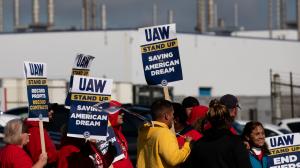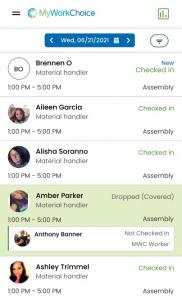Future of Work: The MyWorkChoice Solution to a Four-Day Manufacturing Workweek
The Four-Day Workweek in Manufacturing is Already Here - The Flexible Workforce Model Explained
UNITED STATES, September 27, 2023 /EINPresswire.com/ -- The concept of a four-day workweek is gaining traction, especially in white-collar corporate America.Now, it’s a top demand from the United Auto Workers (UAW) union.
The real question is – Can a manufacturing facility maintain production goals with a 32-hour workweek for employees?
Real-World Challenges: Where the Rubber Meets the Road
To make up the difference in work hours, manufacturers can’t just crank up the assembly line speed by 20% to compensate.
Traditionally, two models have existed to create a four-day workweek in manufacturing:
1. Fixed Four-Day Model
- Workers put in four 10-hour shifts and have a three-day weekend, while the facility is closed during that time.
- The downside here lies in lost production hours if someone fails to show up for a shift; production can’t be made up on the days the plant is closed.
2. Rotating Four-Day Model
- Employees also work four 10-hour shifts but on staggered days to allow for continuous production.
- Complexity in scheduling and absenteeism-related losses are still the challenges here.
Unfortunately, both models fall short. Given that the average U.S. non-farm worker puts in only 34.4 hours a week, it's evident that mandatory overtime and strict attendance policies aren't succeeding in keeping people on the job longer. Instead, it’s having the opposite effect.
Between a Rock and a Hard Labor Market
It’s not just about hours and shifts; it’s about human behavior and the change in labor dynamics.
There are hundreds of job openings in every market for the frontline workforce, with many offering immediate employment.
And gig work is pulling many of these folks to an incredibly attractive “work-when-you-want” schedule.
Why? Because people’s lives are fluid.
Federal Reserve Bank economist Laura Ullrich explained, “…people want to work, but things look different than what they did before. And if companies want to survive, they need to adapt.”
Introducing a Win/Win Third Option: Full-Time with Flexibility
MyWorkChoice presents a third option, emphasizing flexibility while maintaining efficiency.
Flexible 40-Hour Week
- Full-time workers begin with a 40-hour week but can adjust their schedules to swap days, work a shorter shift, or add shifts to earn overtime.
- Workers must maintain at least 32 hours a week to remain full-time employees.
The Backup Pool
- A supplemental group of part-time workers on standby to cover shifts taken off by full-time employees.
- These part-timers are fully trained and can step in immediately, reducing overtime expenses and supporting peak production times.
This model allows employees to have work schedules that align with the realities of modern life. It also attracts a more diverse workforce since students, stay-at-home parents, and semi-retirees can earn a living wage while still taking care of their primary responsibilities.
Sydney M., a MyWorkChoice employee at GE Appliances in Lafayette, GA, said, “I love that I can work a full week, but if there's a day I need to miss due to my kids having appointments or games or even a day for myself, I can without being punished."
Leveraging Technology for Seamless Operations
Managing flexibility would have been a logistical nightmare a decade ago. However, thanks to innovations like MyWorkChoice's Automated Backfill Technology™, implementation is now operationally seamless.
This technology pre-schedules full-time workers, fills any dropped shifts instantly, and streamlines communication between workers and supervisors.
The proof is in the production. Saddle Creek Logistics implemented this model and has maintained a daily shift fill rate of 98% over the last three years, along with seeing productivity increase dramatically.
The Payoff: Flexibility as Currency
Flexibility isn't just a perk; it's an asset. Companies using this model have reported up to 15 times the average worker retention rates versus traditional work schedules.
Bill Good, Vice President of Supply Chain at GE Appliances, said, "MyWorkChoice has worked perfectly to give employees the work-life balance they need."
Manufacturers adopting this flexible workforce model have also seen reduced labor costs, improved quality control, and fewer injuries from fatigue.
The Future of the Manufacturing Workweek
So, is the UAW’s request for a four-day workweek unreasonable? That’s another debate.
But it’s a clear signal for manufacturers to adapt or end up on the scrap heap.
Offering flexibility in a manufacturing plant is now possible thanks to technology, and the companies that have taken steps to “meet workers where they are” have enjoyed the benefits.
Companies with frontline production workers should take this as an opportunity to stay ahead of the curve and make manufacturing attractive again.
Adam Raimond
MyWorkChoice
+1 828-342-1345
adamr@myworkchoice.com
Visit us on social media:
Facebook
Twitter
LinkedIn
Legal Disclaimer:
EIN Presswire provides this news content "as is" without warranty of any kind. We do not accept any responsibility or liability for the accuracy, content, images, videos, licenses, completeness, legality, or reliability of the information contained in this article. If you have any complaints or copyright issues related to this article, kindly contact the author above.



